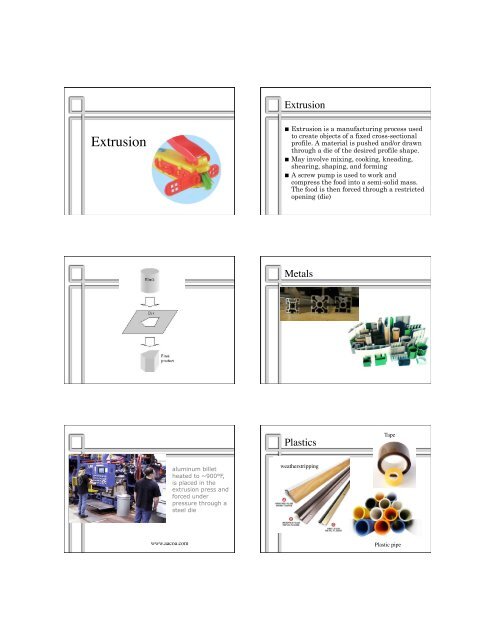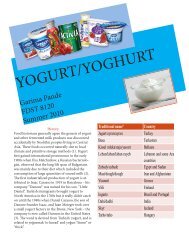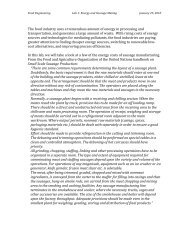You also want an ePaper? Increase the reach of your titles
YUMPU automatically turns print PDFs into web optimized ePapers that Google loves.
Extrusion<br />
www.aacoa.com<br />
aluminum billet<br />
heated to ~900°F,<br />
is placed in the<br />
extrusion press and<br />
forced under<br />
pressure through a<br />
steel die<br />
Extrusion<br />
Extrusion is a manufacturing process used<br />
to create objects of a fixed cross-sectional<br />
profile. A material is pushed and/or drawn<br />
through a die of the desired profile shape.<br />
May involve mixing, cooking, kneading,<br />
shearing, shaping, and forming<br />
A screw pump is used to work and<br />
compress the food into a semi-solid mass.<br />
The food is then forced through a restricted<br />
opening (die)<br />
Metals<br />
Plastics<br />
weatherstripping<br />
Tape<br />
Plastic pipe
plastic pellets which are dried in a hopper before going to<br />
the feed screw. The polymer resin is heated to molten<br />
state as it is fed to the extrusion tooling. The die molds<br />
the heated mass into the desired shape. The extrudate is<br />
cooled and solidified as it is pulled through the die or<br />
water tank.<br />
Food Products<br />
Stuffings, croutons<br />
Crispbread<br />
Cornflakes, cheerios, Crispix<br />
Texturized soy proteins<br />
Confections: liquorice, fruit gums<br />
Dry expanded pet foods<br />
Prefab cookie dough<br />
Snack foods; puffed snack products<br />
www.math.utwente.nl<br />
Plastics<br />
Extruded cereal
Fig Newtons<br />
Sevai<br />
Advantages<br />
Dry cat food<br />
Reduced costs: labor, energy, and processing costs<br />
lower than other cooking and forming methods<br />
High production rates: snacks continuously<br />
produced at 700 lbs/hr; cereals at 2800 lbs/hr.<br />
Versatility: one unit can produce a wide range of<br />
different products by changing a few components<br />
Improved functional characteristics:<br />
solubility and textural characteristic can be<br />
adjusted, e.g. soluble breakfast powders to<br />
chew breakfast cereals.<br />
No process effluents<br />
Textured soy chunks<br />
www.americankuhne.com<br />
= blender + mixer + kneader +<br />
heater/cooking + shaping + portion control<br />
Videos<br />
• Ice Cream Bars<br />
http://www.youtube.com/watch?v=7hXfFfGMT_M<br />
• De-germed maize or corn http://video.google.com/<br />
videoplay?docid=2448334957785560450<br />
• Plastic<br />
http://www.youtube.com/watch?v=j1FcCH8tzNU<br />
http://www.youtube.com/watch?v=KboGBwJQIuw<br />
• Home pasta<br />
http://www.youtube.com/watch?v=SCofPv2Heqs<br />
• Tootsie roll<br />
http://www.youtube.com/watch?v=n263fXBYXi0<br />
• Fish food<br />
http://www.youtube.com/watch?v=LIrsV5CqrM0
Hot or Cold<br />
<strong>Extruder</strong> Types<br />
Extrusion cookers: food is heated by steam jacket<br />
(or electric heater). High pressure, small dies<br />
used to form expanded products as moisture<br />
evaporates outside of die. Low pressure, large<br />
dies for high density products.<br />
High shear products: Snackfoods, croutons,<br />
cereals, meat analogs.<br />
Low shear products: chewing gum, dense<br />
snackfoods<br />
Cold Extrusion: product extruded into strips<br />
without cooking or expansion. Deep<br />
flighted screws at low speed in a smooth<br />
barrel.<br />
– Pasta, hot dogs, pastry doughs, some candies,<br />
ice cream novelties.<br />
– Special die may inject filling into an outer shell<br />
(coextrusion).<br />
Puffed snacks<br />
http://foodprotein.tamu.edu/extrusion<br />
Cherry mash bars<br />
Ram versus Screw<br />
Textured vegetable protein
Ice cream bars<br />
Twin Screw <strong>Extruder</strong>: Two screws rotate in a<br />
figure 8 shaped bore. Advantages:<br />
– throughput independent of feedrate, fluctuations in<br />
production accommodated<br />
– can handle oily, sticky, or wet materials that slip in a<br />
single screw<br />
– Forward and reverse conveying allow greater pressure<br />
control<br />
– Short discharge section, less wear on machine<br />
– Larger variety of feed particle sizes possible<br />
<strong>Extruder</strong> Screw<br />
Extrusion Screw<br />
δ<br />
w<br />
B<br />
θ<br />
Channel<br />
r<br />
Central<br />
shaft<br />
Helical flights<br />
Single and Twin Screw <strong>Extruder</strong>s<br />
Single Screw <strong>Extruder</strong>s: a single screw<br />
with feed, kneading, and cooking/metering<br />
sections.<br />
– Lower capital and operating costs<br />
– Require less skill to operate and maintain<br />
Factors Effecting Nature of Extruded Product<br />
Operating conditions<br />
– Temperature<br />
– Pressure<br />
– Diameter (and shape) of the die<br />
– Shear rate<br />
Rheological properties of the food<br />
apvbaker
Archimedian screw rotates in a tightly<br />
fitting barrel<br />
Relatively shallow flights and mechanism<br />
for compressing food as it moves from<br />
hopper to discharge die.<br />
Screw flights completely filled with food<br />
Rotation causes high shear conditions<br />
– decreasing pitch, constant root diameter<br />
– constant diameter screw, decreasing barrel<br />
The careful control of the screw properties<br />
along the barrel control the degree of mixing,<br />
compression, and even temperature rise<br />
www.technicalwelding.co.uk<br />
Compression accomplished with one of<br />
several designs<br />
– increasing root diameter<br />
– decreasing pitch, decreasing barrel<br />
– restrictions in barrel
Screw Sections<br />
Feed section: has deeper flights or with<br />
greater pitch. Feed falls easily into screw<br />
and begins to be conveyed.<br />
Transition or compression region: granular<br />
or sticky mass converted to a uniform<br />
plasticized dough. Product compacted,<br />
mixed, and worked.<br />
Metering section: shallow flights, reduced q<br />
used to thoroughly mix and/or increase T<br />
Other Components<br />
Extrusion stand: base that supports the<br />
drive, bearings, and extrusion barrel and<br />
screw<br />
Drive mechanism: usually an electric motor<br />
operating through gear reduction to obtain<br />
proper speed. Drive attached to screw via<br />
flexible coupling.<br />
Barrel: Usually bolted together sections<br />
containing cylinder within which screw<br />
rotates. Usually hardened surface to limit<br />
abrasion caused by high shear conditions.<br />
Common diameters: 2.54 - 20.32 cm. Long<br />
barrels give more surface for heating/<br />
cooling, longer residence time => more<br />
control. L/D range from 3:1 to 25:1.<br />
Normal operating pressures: 15 - 70 atm.<br />
Hopper<br />
Feeder<br />
FEED<br />
SECTION<br />
COMPRESSION<br />
SECTION<br />
Steam Jacket<br />
METERING<br />
SECTION<br />
Thrust bearing: extrusion screw supported<br />
by bearing at driven end. Rearward thrust<br />
must be absorbed to compensate for force<br />
imparted to extruded food as it moves<br />
forward.<br />
Feed hopper: opening through which feed<br />
materials enter screw. Often with agitators,<br />
offset, and with cooling jackets to enhance<br />
feed. May be dry grits, flours, sticky<br />
doughs, etc.<br />
Barrel temperature control: heat is added/<br />
removed from sections of barrel surface.<br />
Hollow jackets around barrel can accept<br />
steam or cooling water. Temperature of last<br />
barrel most commonly varied to achieve<br />
desired product temperature. Steam<br />
injection sometimes used.<br />
Die
Temperature sensing: T of product sensed<br />
just behind die (melt temperature).<br />
Temperatures along barrel also often<br />
monitored with thermocouple probes.<br />
Pressure sensing: pressures just behind die<br />
are useful.<br />
Breaker plate: perforated metal discs<br />
between end of screw and die. Stops hard<br />
uncooked pieces from entering die and<br />
plugging. Also enhances back-mixing.<br />
Estimated moisture loss<br />
mC p(T 1 − T 2) = m(M 1 − M 2 )ΔH v<br />
M 2 = M 1 ΔH v − C p (T 1 − T 2 )<br />
ΔH v<br />
m =mass flow rate of food, Cp=ht capacity, M=moisture<br />
content, ∆Hv=latent heat of vaporization (at ambient pressure),<br />
1 = before die 2 = after die.<br />
Food Properties During Extrusion<br />
200<br />
Temp<br />
(°C)<br />
0<br />
Flour H 2O<br />
Feed Zone<br />
Venting<br />
Plasticizing<br />
Zone<br />
Pressure<br />
Build-up Zone<br />
Die: shaped holes through which exudate<br />
emerges. May form rods, spheres, donuts,<br />
tubes, strips, etc. Expansion occurs as<br />
product leaves because of rapid release of<br />
pressure from the end of the extruder to<br />
ambient conditions. Flashing of moisture<br />
occurs (H 2 O was above normal TB).<br />
High P,<br />
High T<br />
Product<br />
50<br />
Moisture<br />
(%)<br />
0<br />
Flour H 2O<br />
Feed Zone<br />
Atmospheric Pressure<br />
T > T b<br />
Venting<br />
Steam<br />
Steam leaves product and<br />
expands matrix. As moisture<br />
content decreases, structure<br />
solidifies.<br />
Plasticizing<br />
Zone<br />
Pressure<br />
Build-up Zone
1<br />
Density<br />
(g/cm 3 )<br />
0<br />
Flour H 2 O<br />
Feed Zone<br />
Venting<br />
Plasticizing<br />
Zone<br />
Pressure<br />
Build-up Zone<br />
50<br />
Pressure<br />
(bar)<br />
0<br />
Flour H 2 O<br />
Feed Zone<br />
Venting<br />
Plasticizing<br />
Zone<br />
Pressure<br />
Build-up Zone





